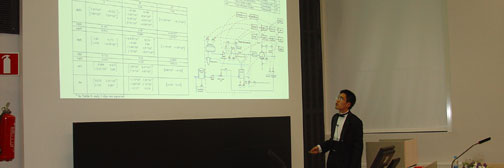| | Year 2002
Timo MalmiUniformity of quality at Metsä-Botnia Ab’‘s Kaskinen plant
By the help of modeling the statistical multivariate methods provide an opportunity to study huge datamatrixes and to create monitoring systems for supporting the process control. Off- line models tell us about the interactions between the process variables and enable the study of disturbance state. The aim of this thesis was by off-line modeling to find the most important variables that in the fiber line create changes in brightness, tensile strength, elastic modulus and beating energy requirement.
In the literature part the statistical multivariate methods, principal component analysis (PCA) and partial least squares projections to latent structures (PLS) are considered. In addition to the theoretical study the applicability of the methods is analyzed from the viewpoint of process research. Three cases using the multivariate methods in pulp production are represented.
In the experimental part the fiber line of the Kaskinen pulp mill is modeled starting from cooking in order to find and analyze the most important variables that have an effect on the chosen quality variables of Birch- ECF pulp. The brightness study is carried out by dividing the brightening process in 5 steps and the strength quality study in two parts depending on the use of SiMo- activation chemical. PLS-DA models were made for the strength quality variables to detect the variables that exhibit the strongest discrimination power.
The brightness study showed that the brightnesses in D/0 and E/O- stages modeled best because of their biggest variance. The most important variables for brightness were the brightening chemical portions, washing efficiency, alkalinity in the cooking stage and the changes of pH and mass flow in the ozone stage.
The data for strength study was collected during 14 months. For tensile strength, elastic modulus and beating energy requirement several shared and separate central variables. The changes in tensile strength were strongly affected by cooking kappa number, pulp species, pulp consistency, pH of the water extract and the conductivity of VHL- condensate. The most important variables for elastic modulus were cooking kappa number, pulp species, pulp consistency, viscosity and the quality of NaOH used in oxygendelignification. Beating energy requirement was strongly affected by pH of the water extract, pulp species, conductivity of the washing waters and oxygen gas portion.
In connection with the results, oxidized NaOH and make-up NaOH were combined in oxygen delignification to smooth the quality of used NaOH. The goal of the cooking kappa number has been started to raise in order to improve the strength qualities of Birch- ECF pulp and cooking efficiency. It is recommended to pay more attention to the changes in the quality of washing waters and to maximize the washing periods in the evaporation department so as to control the conductivity of VHL- condensate. According to the results, by controlling pH of the water extract it is possible to affect the beating energy requirement and thus all the strength qualities of pulp.
Deprecated: strlen(): Passing null to parameter #1 ($string) of type string is deprecated in C:\WWWroot\Root\incs\5_theses\theses_new2010.php on line 248
This info last modified 02 Jul 2025 by Jerri Kämpe-Hellenius
|

